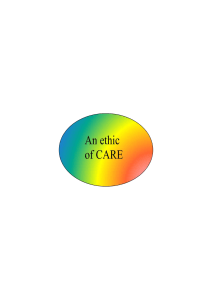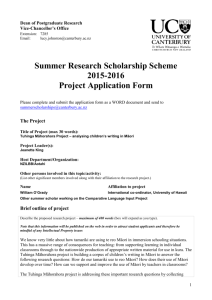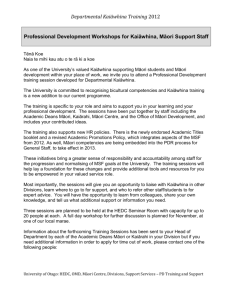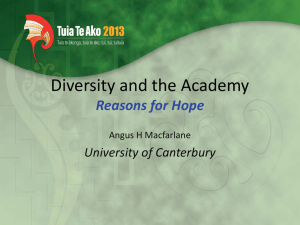Registered Teacher Criteria
advertisement
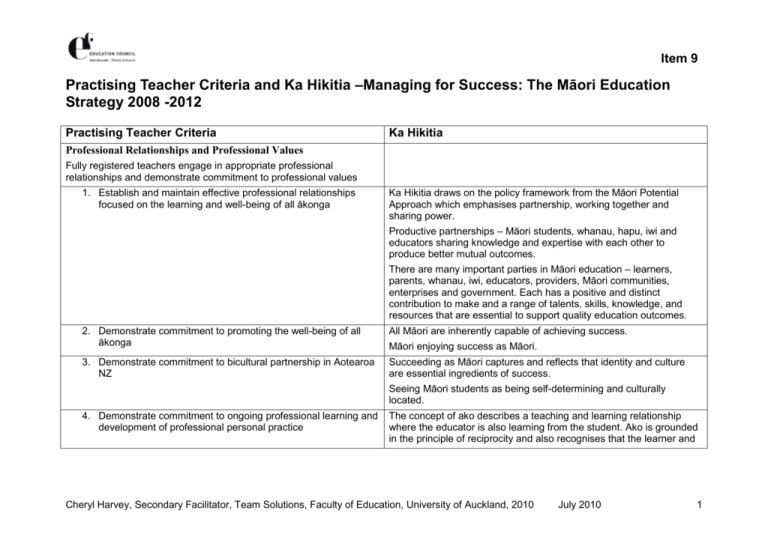
Item 9 Practising Teacher Criteria and Ka Hikitia –Managing for Success: The Māori Education Strategy 2008 -2012 Practising Teacher Criteria Ka Hikitia Professional Relationships and Professional Values Fully registered teachers engage in appropriate professional relationships and demonstrate commitment to professional values 1. Establish and maintain effective professional relationships focused on the learning and well-being of all ākonga Ka Hikitia draws on the policy framework from the Māori Potential Approach which emphasises partnership, working together and sharing power. Productive partnerships – Māori students, whanau, hapu, iwi and educators sharing knowledge and expertise with each other to produce better mutual outcomes. There are many important parties in Māori education – learners, parents, whanau, iwi, educators, providers, Māori communities, enterprises and government. Each has a positive and distinct contribution to make and a range of talents, skills, knowledge, and resources that are essential to support quality education outcomes. 2. Demonstrate commitment to promoting the well-being of all ākonga All Māori are inherently capable of achieving success. 3. Demonstrate commitment to bicultural partnership in Aotearoa NZ Succeeding as Māori captures and reflects that identity and culture are essential ingredients of success. Māori enjoying success as Māori. Seeing Māori students as being self-determining and culturally located. 4. Demonstrate commitment to ongoing professional learning and development of professional personal practice The concept of ako describes a teaching and learning relationship where the educator is also learning from the student. Ako is grounded in the principle of reciprocity and also recognises that the learner and Cheryl Harvey, Secondary Facilitator, Team Solutions, Faculty of Education, University of Auckland, 2010 July 2010 1 Item 9 whanau cannot be separated. Continuous improvement of effective teaching and learning that lifts Māori student achievement. Integrate the best evidence of what works for and with Māori students into all professional development programmes. 5. Show leadership that contributes to effective teaching and learning The strategy has been designed to concentrate on what evidence shows will achieve a transformational shift in the performance of the educational system for and with Māori. Māori learners excel and successfully realise their cultural distinctiveness and potential. Effective teaching and learning depends on the relationship between teacher and student, and the active engagement and motivation of the students by the teacher. Effective teaching practices require learning contexts that are meaningful for the learner, accurate assessment and responsive feedback that supports further learning. Transforming the system will require a better understanding of the link between teaching practice and learning outcomes. Cheryl Harvey, Secondary Facilitator, Team Solutions, Faculty of Education, University of Auckland, 2010 July 2010 2 Item 9 Professional Knowledge in Practice Fully registered teachers make use of their professional knowledge and understanding to build a stimulating challenging and supportive learning environment that promotes learning and success for all ākonga. 6. Conceptualise, plan and implement an appropriate learning programme Culture counts – knowing, respecting and valuing who students are, where they come from and building on what they bring with them. Use diagnostic and formative assessment data to inform the levels at which teaching and learning should be pitched. 7. Promote a collaborative supportive learning environment Emphasises the importance of Ako - Effective and reciprocal teaching and learning - for and with, Māori Learners and the conditions that support it. Māori learners working with others to determine successful learning and education pathways. 8. Demonstrate in practice their knowledge and understanding of how ākonga learn All Māori learners have unlimited potential. Engagement in meaningful and relevant learning. Demonstrate that education is relevant, worthwhile and connected to the students life goals and contexts. Listen to and support students in the classroom in their decision making and in school life. Student engagement and achievement improves when teachers develop positive teaching and learning relationships with Māori students. Peer culture also has a significant influence on presence, engagement and achievement at school and also on behaviour and attitudes. Schools have a critical role in helping students support each other. 9. Respond effectively to the diverse and cultural experiences and the varied strengths, interests and needs of individuals and groups of ākonga All Māori have cultural advantage by virtue of who they are – being Māori is an asset not a problem. Increased student involvement in and responsibility for decision Cheryl Harvey, Secondary Facilitator, Team Solutions, Faculty of Education, University of Auckland, 2010 July 2010 3 Item 9 making about future education pathways. Use a culturally responsive pedagogy. 10. Work effectively within the bicultural context of Aotearoa NZ Culture and education are inextricably interwoven in the education system as well as in the learning setting. Māori children and students are more likely to achieve when they see themselves, their whanau, hapu and iwi reflected in the teaching content and environment and are able to be Māori in all learning contexts. Improved whanau-school partnerships focused on presence, engagement and achievement. 11. Analyse and appropriately use assessment and information, which has been gathered formally and informally Disaggregate data from asTTle, PAT, NCEA, in-class work, SMS (attendance, suspensions), student voice and analyse to inform planning, teaching and learning and next steps. 12. Use critical inquiry and problem-solving effectively in their professional practice. Effective evidence-based professional development and accountable leadership. Use the inquiry model (NZC) to reflect on teaching and learning with a view to changing practice or strategies in order to accommodate the individual learning needs and styles of ākonga. Cheryl Harvey, Secondary Facilitator, Team Solutions, Faculty of Education, University of Auckland, 2010 July 2010 4




